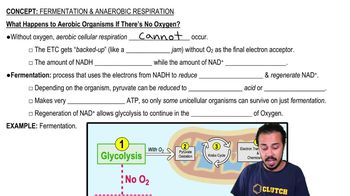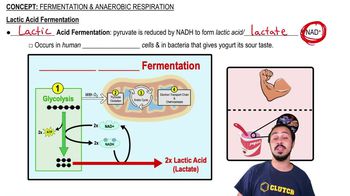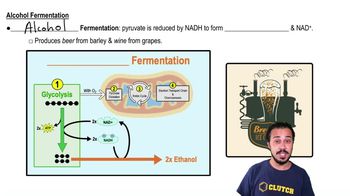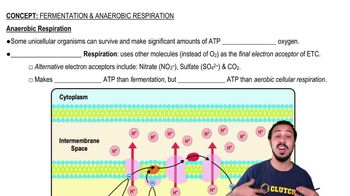8. Respiration
Fermentation & Anaerobic Respiration
Learn with other creators
Practice this topic
- Multiple Choice
Fermentation allows a cell to:
a) Recycle NADH to NAD+ for glycolysis.
b) Use NADH as a terminal electron acceptor.
c) Reduce NAD+ to NADH for glycolysis.
d) Synthesize ATP via ATP synthase.
- Multiple Choice
Which of the following describes a primary function of both lactic acid fermentation and alcohol fermentation?
a) Reduction of NAD+ to NADH.
b) Oxidation of NADH to NAD+.
c) Reduction of FAD to FADH2.
d) Hydrolysis of ATP to ADP.
- Multiple Choice
In which of the steps of aerobic and anaerobic cellular respiration does substrate-level phosphorylation occur?
a) In glycolysis only.
b) In the Krebs cycle only.
c) In the electron transport chain only.
d) In both glycolysis and the Krebs cycle.
e) In both the Krebs cycle and the electron transport chain.
- Multiple Choice
Which of the following statements about NAD+ is true?
a) NAD+ is reduced to NADH during glycolysis, pyruvate oxidation, and the Krebs cycle.
b) NAD+ has more chemical energy than NADH.
c) NAD+ donates high energy electrons to the electron transport chain.
d) In the absence of NAD+, glycolysis can still function.
- Open QuestionWhich metabolic pathway is common to both fermentation and cellular respiration of a glucose molecule?a. the citric acid cycleb. the electron transport chainc. glycolysisd. reduction of pyruvate to lactate
- Open QuestionWhich of the following correctly describe the fermentation pathway? Select True or False for each statement.T/FIt includes a reaction that oxidizes NADH to NAD+.T/FIt synthesizes ATP by substrate-level phosphorylation.T/FIt includes a reaction that reduces NAD+ to NADH.T/FIt synthesizes electron acceptors, so that cellular respiration can continue.
- Open QuestionWhich of the following is a distinction between cellular respiration and fermentation?a. the transfer of from intermediate substrates to ADPb. the movement of H+ across a membrane down its concentration gradientc. the splitting of glucose into two molecules of pyruvated. electrons moving through the electron transport chain
- Open QuestionIn which of the following is the first molecule becoming reduced to the second molecule?a. pyruvate → acetylCoAb. pyruvate → lactatec. glucose → pyruvated. NADH + H+ →NAD+ + 2H














